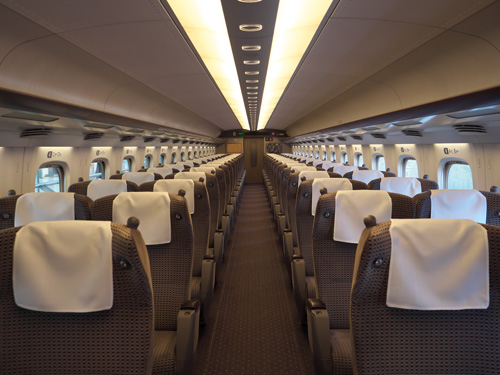
Japan’s Shinkansen is a “bullet train”, an unparalleled mass transit system. This article sheds light on a masterly organisational feat that has thoroughly revolutionised Japan.

Average delay per train 6 seconds (©Kristina Blokhin – stock.adobe.com)
In the 20th century, many Western countries – above all the USA – started to rely heavily on private motorised transport. The rail network was trimmed, downscaled and neglected. Japan took a different approach early on, with efforts to establish an efficient and reliable method to connect its metropolitan areas. The idea of a high-speed train was toyed with back in the imperial era, with the plans finally taking shape in the post-war period. After the war, the plans finally became more concrete, and in 1950 the first Shinkansen prototype achieved a speed record of 163 km/h and prepared the ground for a modern and interconnected Japan. The first Shinkansen line connected the capital Tokyo with the port of Osaka.

Speeds up to 320 km/h (©Yongyuan Dai / istockphoto.com)
As usual in Japan, the government rail project was completed on time and on budget. The Shinkansen was a resounding success and by the early 1980s had been extended to four highly advanced lines permitting speeds of up to 300 km/h. Today, the trains on the various Shinkansen routes are coordinated by six separate operators. Depending on the line, the Shinkansen travels at up to 320 km/h in regular operation and, since its inauguration, has been operating without any major accidents.

Over 150.000.000 passengers each year (©krblokhin / istockphoto.com)
Any fears that six different operators might cause organisational chaos proved unfounded in Japan. Although over 150 million passengers travel on the Shinkansen every year, the average delay per train is six seconds (Shinkansen delays are given in seconds!). While rail passengers in European Express trains can only dream of such figures, efficiency is a given in Japan. This can be explained culturally by the way problems are dealt with in Japan.
Basically, there are two ways to respond to a problem:
1. Remedy the consequences of the problem, express surprise, regret and so forth, apportion blame and carry on as before.
2. Analyse the causes of the problem, remedy them and thus prevent the error from occurring again.
Traditionally, the second option is preferred in Japan. “Kaizen” is the Japanese philosophy of life and work. It involves continuous improvement and the never-ending quest for perfection. The Shinkansen is a magnificent symbol of kaizen and demonstrates graphically how the philosophy is applied in everyday life. The slightest delays, interruptions or technical defects are investigated by the railway companies. On both the technical and staff levels, strict guidelines and targets apply and must always be met. Discipline and punctuality are among the most important social values in Japan and are the prerequisites for the smooth operation of the Shinkansen.
Japan’s Shinkansen is not just “any old” high-speed train. In fact, it is nothing less than a technical masterpiece. The bullet trains run on specially manufactured Shinkansen tracks and not on ordinary rails. The Shinkansen’s tracks come with everything that is required for a safe, punctual and comfortable journey: rails laid on reinforced concrete slabs, extra-long individual rails, sprinklers between the rails for protection from snow, ice and fire, wireless collision warning systems, curve radii of at least 2,500 metres, airtight tunnels and no level crossings. The high-speed lines extend from the northern island of Hokkaido via Honshu and Shikoku to Kyushu in the southwest of Japan. At over 27,000 kilometres, the network is one of the world’s most highly developed high-speed rail systems.

Green Car / 1st class on the Shinkansen train
In many parts of the world, public transport doesn’t enjoy a good reputation and is often considered slow, unpunctual, dirty and uncomfortable and reserved for the underprivileged. Not so in Japan, for not only is the Shinkansen fast, practical and punctual, it is also one of the most luxurious and exclusive means of transport in the world. The express trains are divided into two classes, with Ordinary corresponding to 2nd class and Green Car to 1st class.  The 2nd class of the Shinkansen is comparable to 1st class in Europe; ample legroom, large comfortable seats and an impressive travel experience. On some routes there is also a Grand Class, which even outshines the Green Car. Private seats that can be reclined up to 45 degrees, cuisine courtesy of Michelin-starred chefs and a wide selection of alcoholic beverages. The Shinkansen is a great way to travel!
The 2nd class of the Shinkansen is comparable to 1st class in Europe; ample legroom, large comfortable seats and an impressive travel experience. On some routes there is also a Grand Class, which even outshines the Green Car. Private seats that can be reclined up to 45 degrees, cuisine courtesy of Michelin-starred chefs and a wide selection of alcoholic beverages. The Shinkansen is a great way to travel!
Fields marked with a * are mandatory.
Mitsubishi Electric Europe B.V.
German Branch
Mitsubishi-Electric-Platz 1
D - 40882 Ratingen
Sales
Tel.: +49 (0)2102 / 486 - 6120
edm.sales@meg.mee.com
Service
Tel.: +49 (0)2102 / 486 - 7600
edm.hotline@meg.mee.com
Applications
Tel.: +49 (0)2102 / 486 - 7700
edm.applikation@meg.mee.com
Spareparts
Tel.: +49 (0)2102 / 486 - 7500
edm.parts@meg.mee.com